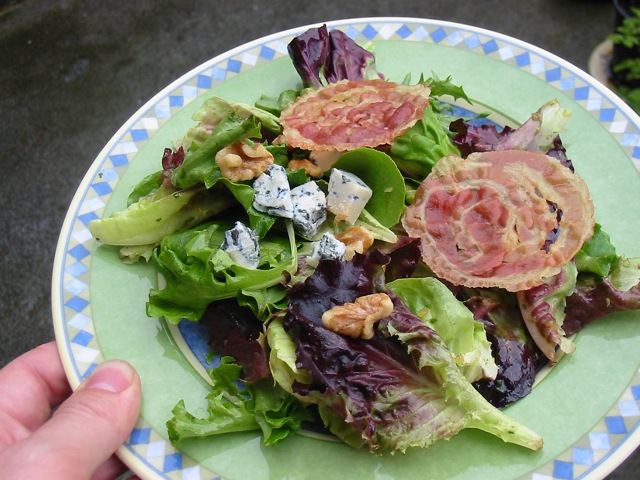
promo-image, l
(article, Matthew Amster-Burton)
[%pageBreakSettings nobreak=true] Every amateur cook has an undiscovered country, an area of cuisine or technique into which he never ventures. For many people, it's baking or fish cookery. Mine, embarrassingly enough, is salad. What could be intimidating about a salad? I blame one great cook for scaring me away from salad, and another for luring me back to it. The salad bogeyman is Jeffrey Steingarten, whose 1988 essay “Salad, the Silent Killer” (found in his book The Man Who Ate Everything) detailed the cocktail of toxic phytochemicals lurking within raw vegetables. It wasn't that the piece actually convinced me that salad is dangerous. It convinced that it was cool not to like salad, which I didn't like anyway. [%image promo-image float=right width=400 caption="The ultimate green salad." credit="Photo courtesy Matthew Amster-Burton"] Now, if you're saying, "Didn't like salad? He must not have been eating good salad," you're absolutely right. Eventually I gave in and learned about which kinds of salads tickled my palate. Sometimes I would even order one in a restaurant, but I was almost never moved to make salad at home. Then, last year, I went to Idaho and ate the ultimate green salad. Since Idaho isn't in my neighborhood, I had to learn to make it myself. "Salad" is an omnibus term for all sorts of dishes. I'm talking about the Euro-American salads based on lettuce, possibly with a flourish of more assertive greens. Within this genre of salad, you could draw a continuum like so: lettuce, oil, vinegar <–––––––––––> creamy chicken caesar with bacon My problem, I realized, was that I wanted to join Alice Waters on the Salad Left and love the lettuce for its own sake, but in truth I'm more of a pragmatic centrist. I don't want my lettuce obliterated by a protein hunk, but I require plenty of the salty and crunchy bits that make life great: Bacon Crumbled blue cheese Hard cheeses, such as Parmigiano-Reggiano or Pecorino Romano Those breaded discs of goat cheese Toasted nuts Croutons Roasted bell pepper, asparagus, or other vegetables in garnish-sized portions Olives or capers Anchovies You get the idea. (For dozens more ideas, consult Nancy Silverton's new book [%bookLink code=1400044073 "A Twist of the Wrist"]. The book is about cooking with quality jarred and canned foods, many of which are appropriately salty and, as my daughter likes to say, pickly.) Now, let's go to Idaho and meet the salad savior. Paul Donaghue is the chef at the Idaho Club in Sandpoint. Bearded and ponytailed, he's a bit of a wildman. (No, not in the Hell's Kitchen mold; he’s more of a Pacific Northwest backwoods outdoorsman.) When I met Paul, he had a nasty gash on his arm from the previous day's mountain-biking accident. Everyone in Sandpoint calls him "Chef." I was there to write a profile of the chef. Since his restaurant was under construction, he made me dinner at his house. We had shallot-crusted salmon, fennel confit, and red-curry clams, but the salad was the best part. The lettuces were grown at a nearby organic farm and picked a couple of hours before dinner. (This wasn't just menu-speak; I was there for the picking.) Paul crisped some rounds of pancetta in a skillet, then toasted hazelnuts in the rendered fat. He found some homemade roasted-shallot vinaigrette in the fridge and used this to dress the greens, which he then topped with the hazelnuts, pancetta, and crumbled gorgonzola. This salad was no wallflower, but nothing was used to excess, either. Each bite brought together the sweetness of just-picked leaves with the aged flavors of bacon and blue cheese. I liked how the stickiness of the cheese kept the crunchy elements from fighting. And the homemade dressing tied it together without being overly oily or sweet. For a salad centrist like me, this was perfection. When I finally got around to recreating it at home, I had several happy realizations. First, the salad mix at your local farmers’ market is much better than anything available in a controlled-atmosphere bag. This sounds obvious, but occasionally I prefer the conventional supermarket version of a product to the local, organic version (fennel is an example), and this causes me some cognitive dissonance. With salad, I can respect my palate and my local economy. And the best time for spring mix is, well, now. Second, making a good vinaigrette is not hard. The day I last made this salad dressing, it was too hot to turn on the oven for roasted shallots, so I cheated and made caramelized onion vinaigrette. I sliced an onion thin, browned it in olive oil, and whizzed it together (using an immersion blender) with more oil, balsamic vinegar, parsley, thyme, salt, and pepper. I'll give the recipe below, but you don't actually need a recipe. Third, homemade dressing keeps well in the fridge, and I found a great product for keeping it in. Ball, the Mason-jar company, makes "freezer jars," which are not jars at all but reusable plastic cups with screw-on lids. You can shake and transport them with no chance of leakage. Ziploc is making something similar now, too. [[block(sidebar). h1.Featured recipe ]] So I used the same dressing for several salads in the same week. Paul's salad, of course. One with smoky bacon and toasted walnuts. One with Parmesan and arugula. Then I varied the dressing, blending the walnuts into the vinaigrette and trying different vinegars. In doing so, I became one of these people disdained by Steingarten: bq. They think nothing of interrupting a perfectly nice meal with their superstitious salad ritual — heads bowed, snouts brought close to their plastic wood-grained bowls, crunching and shoveling simultaneously — their power of conversation lost. I can live with that. Where can I buy some plastic wood-grained bowls? p(bio). [matthew.reviews@gmail.com "Matthew Amster-Burton"]* writes about cooking and culture from his home in Seattle. He keeps a blog titled Roots and Grubs.

promo-image, l

reference-image, l